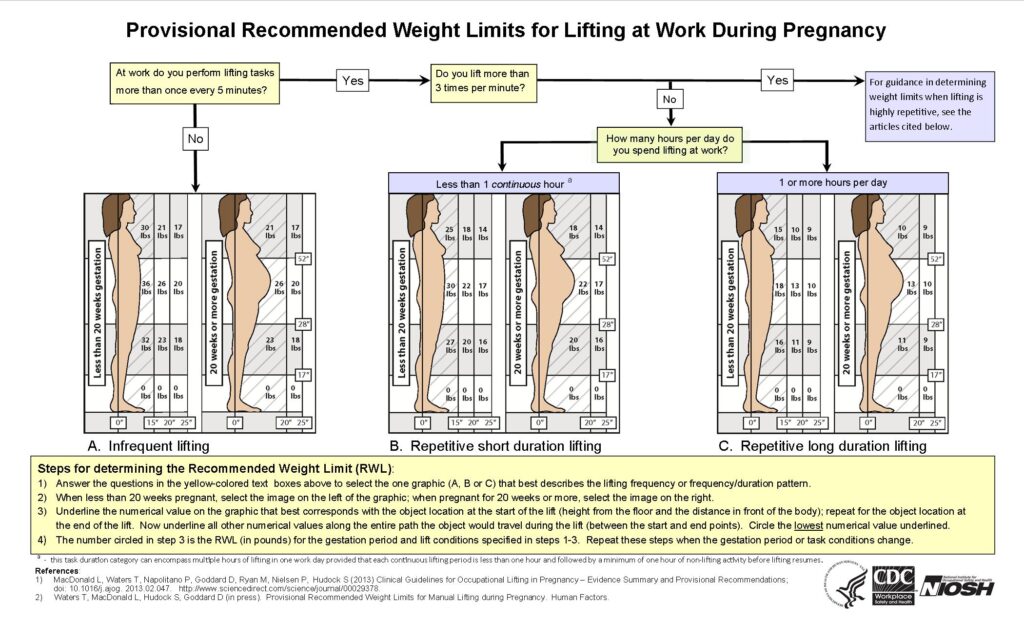Lifting While Pregnant:
According to the Centers for Disease Control and Prevention lifting weight above the recommended weight limits can cause miscarriage late in pregnancy and premature delivery. If you are lifting while pregnant at work it would be a very good idea to discuss lifting and the implications it may have on your unborn child, with your employer. Below is a chart which you can reference.
Recommended Weight Limits for Lifting at Work During Pregnancy:
NIOSH has put together a very easy to interpret chart displaying recommended weight limits for lifting at work during pregnancy. Feel free to print out the image and take it with you to work for a reference.
Which Chart to Use:
- Start at the top of the page. Ask yourself, do you perform lifting tasks more than once every 5 minutes?
- If you answer No then you do not perform lifting tasks more than once every 5 minutes (this would be a minimum of 24 lifting tasks per one hour) then use the first chart.
- If you answered yes to the first question then we need to determine if you’ll be using the second or third chart. If you lift more than 3 times per minute (which would be a minimum of 240 lifting tasks per one hour) then further information is needed and should be discussed with your employer.
- If you answer No then you do not perform lifting tasks more than once every 3 minutes. This means you can use either the second or third chart.
- If you spend less than 1 continuous hour lifting more than once every 5 minutes then you will use the second chart.
- If you lift more than once every 5 minutes for 1 or more hours per day then you will use chart 3.

How to Use the Chart:
Now that you have selected the appropriate chart let’s learn how to use it. For this example I will be using the first chart, assuming the worker is performing lifting tasks less than once every 5 minutes. You’ll notice on the charts there are two women, on the left hand side the woman is less than 20 weeks gestation while on the right hand side the woman is 20 weeks gestation or more.
In this example we will assume the woman is 5 weeks gestation. This means we will be using the left hand side of chart one. You’ll see horizontal lines and vertical lines. We need to define what these mean.
The horizontal lines display the level at which the lift will start. This simply means the height at which the object is at before it is picked up. The vertical lines display how many inches away the object is from the body at the start of the lift.
Now that we know which chart to use, which side to use, and what the horizontal and vertical lines mean we can now determine the recommended weight limit for a lift at a specified height and distance away from the back of the body. Notice where the 0 inches starts. You start measuring from the heel. Do not measure from the toes.
Continuing with our original example, let’s assume the worker needs to lift a box from a shelf. She has complete access to the shelf so she can get right up next to the box. The shelf is approximately 50 inches off the ground. This means we will be using the 15 inch vertical line. Everything up to 15 inches away from the 0 inches starting point is recommended for this lift.
Follow the 15 inches vertical line up until you hit the 52 inches horizontal line. The box says 36 lbs. This means she can lift up to 36 pounds at this height and distance away from the 0 inches line less than once every 5 minutes.
Notice from her feet to her mid-calf there are zeros in all the boxes. This means it is not recommended to lift any amount of weight from the ground level.
Are you Pregnant and Do You Have to Lift from the Ground Level?
Take action:
Want to help make an impact on childhood illness? If you found this chart and information to be helpful please share it with your friends and family. What one does not know may damage their unborn child. A simple chart to reference and follow may make a world of a difference to an unborn child during gestation. We’ve tried to make it as easy as possible to share this important blog post. Simply click on “pin it” if you are on pinterest or share via your favorite social network.
Further information:
Consider browsing to the CDC’s website to read about other reproductive health and the workplace.
